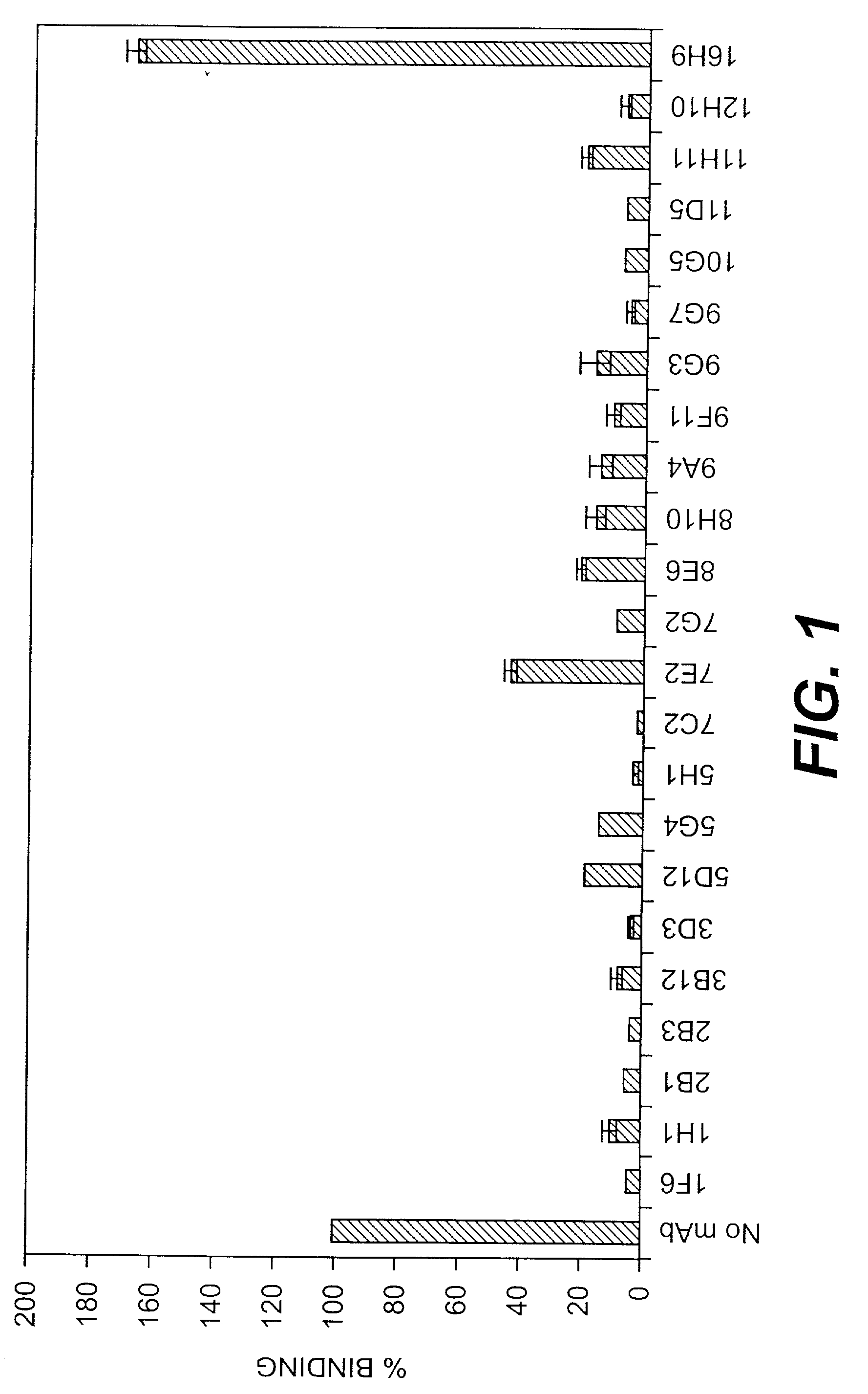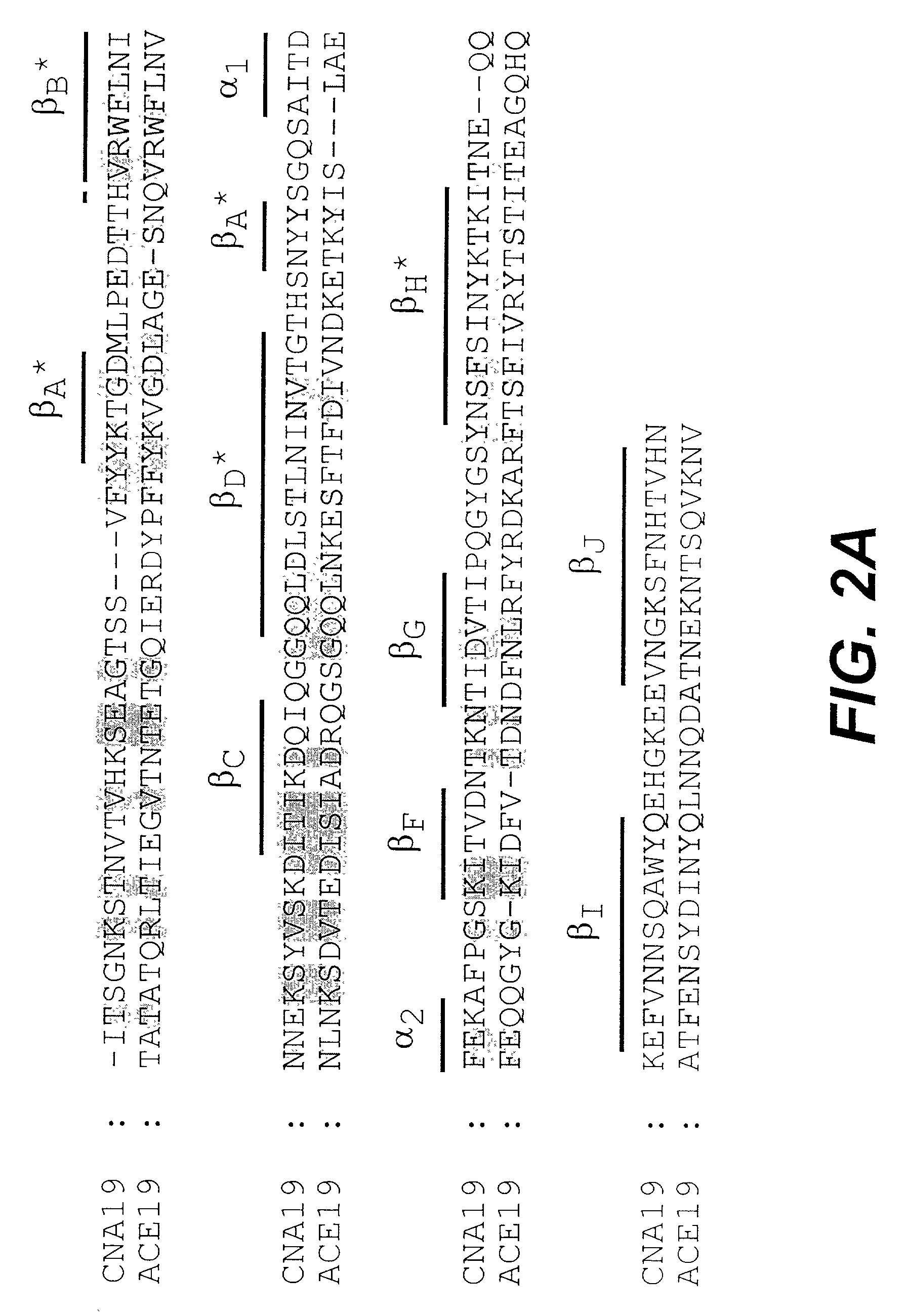Cross-reactive displacing antibodies from collagen-binding proteins and method of identification and use
- Summary
- Abstract
- Description
- Claims
- Application Information
AI Technical Summary
Benefits of technology
Problems solved by technology
Method used
Image
Examples
example 1
Generation of Monoclonal Antibodies and Demonstration of Displacement Effects and Cross-Reactivity
[0079] Bacterial strains, plasmids and culture conditions—Escherichia coli strain JM101 was used as a host and pQE-30 (Qiagen Inc., Chatsworth, Calif.) as an expression vector for cloning and expressing recombinant proteins. Staphylococcus aureus strain Cowan I was a clinical isolate from the Instituto Seroterapico Milanese (Milan, Italy) (18). S. aureus strains 57, 72, 116, 175, 176, 180, 203, 205, 212, and 4046 were clinical isolates from China, Europe, Hong Kong, Singapore and the United States. All these S. aureus isolates bind collagen (data not shown). E. coli strains were grown in Lennox L Broth (LB) (SIGMA, St. Louis, Mo. 63178) or on LB agar at 37° C. overnight with antibiotics when appropriate. Staphylococci were grown in Brain Heart Infusion (BHI) (DIFCO, Detroit, Mich. 48232-7058) broth or on BHI agar at 37° C. overnight.
[0080] Generation of monoclonal antibodies—Monoclona...
example 2
Characterization of Monoclonal Antibodies and Mapping of Epitopes
[0100] Initial characterization of monoclonal antibodies—22 monoclonal antibodies against CNA19 were isolated. The isotype of each of the 22 mAbs raised against CNA19 and 16H9, which was raised against the full-length A domain of CNA, CNA55, was determined (Table 2). The majority of the mAbs were of IgG1-k type, six were of IgG2a-k (2B3, 3D3, 7C2, 8H10, 11D5, and 11H11), and one (1F6) was of IgG2b-k type.
[0101] ELISA assays were carried out to determine the apparent KD values for CNA19 of each of the 22 mAbs and 16H9 (Table 2). The majority of the mAbs showed similar KD value, at the 10−9 M range. 5G4 showed a slightly lower affinity with a KD of 2.9×10−8 M and 8E6 a slightly higher affinity with a KD of 7.5×10−10 M.
[0102] The percentage binding of 125I-collagen to immobilized CNA19 after the addition of 2 μg of each mAb was shown in FIG. 1. The 22 mAbs against CNA19 showed inhibitory effects on collagen binding of ...
example 3
In Vitro Demonstration of MAB Efficacy
Antibody Scale-up and Purification
[0120] Hybridoma cells were grown in RPM1 / DMEM, 1× Nutridoma-SP media containing 2 mM sodium pyruvate, 4mM L-glutamine and 2× penicillin-streptomycin to 2-3 liter culture volumes. Hybridoma supernatants were then harvested by centrifugation. The supernatants were filtered through 0.45 μM filters and the IgG was affinity purified using protein G chromatography. The monoclonal antibodies was eluted using 0.1M glycine, pH 2.7 and immediately neutralized with one tenth volume of 2M Tris, pH 8.0. The purified IgG was then dialyzed against 1×D-phosphate buffered saline, pH 7.4. If needed, the purified antibody was concentrated and aliquots frozen.
S. aureus
[0121]S. aureus strain Barnett was isolated from a patient with osteomyelitis. S. aureus bacterial cells from a frozen glycerol stock were streaked onto a single blood agar plate. Single colonies from the initial plate were then restreaked on approximately 30 bl...
PUM
| Property | Measurement | Unit |
|---|---|---|
| Angle | aaaaa | aaaaa |
| Angle | aaaaa | aaaaa |
| Angle | aaaaa | aaaaa |
Abstract
Description
Claims
Application Information
 Login to View More
Login to View More - R&D
- Intellectual Property
- Life Sciences
- Materials
- Tech Scout
- Unparalleled Data Quality
- Higher Quality Content
- 60% Fewer Hallucinations
Browse by: Latest US Patents, China's latest patents, Technical Efficacy Thesaurus, Application Domain, Technology Topic, Popular Technical Reports.
© 2025 PatSnap. All rights reserved.Legal|Privacy policy|Modern Slavery Act Transparency Statement|Sitemap|About US| Contact US: help@patsnap.com



